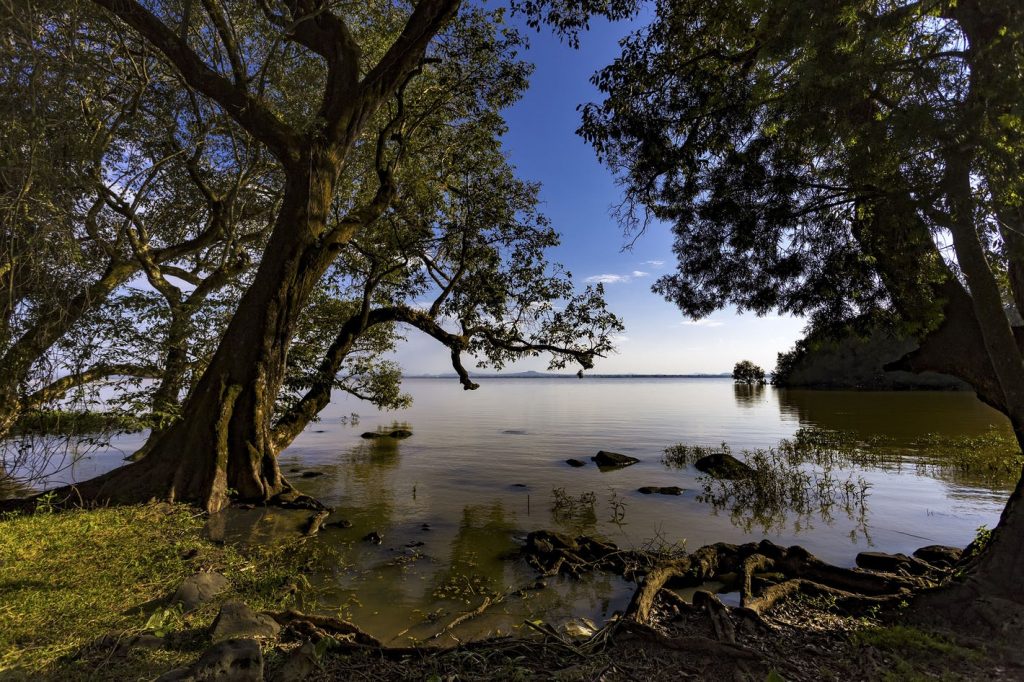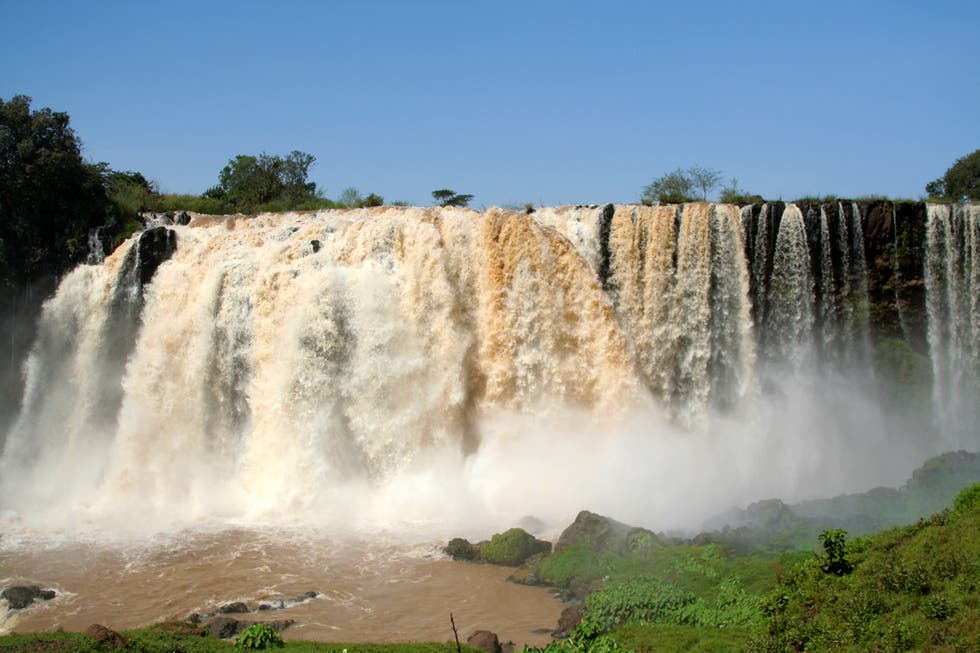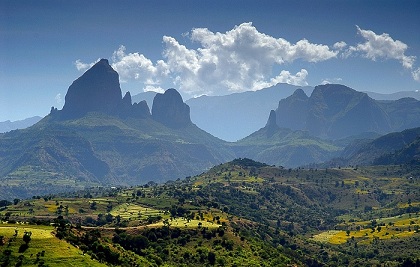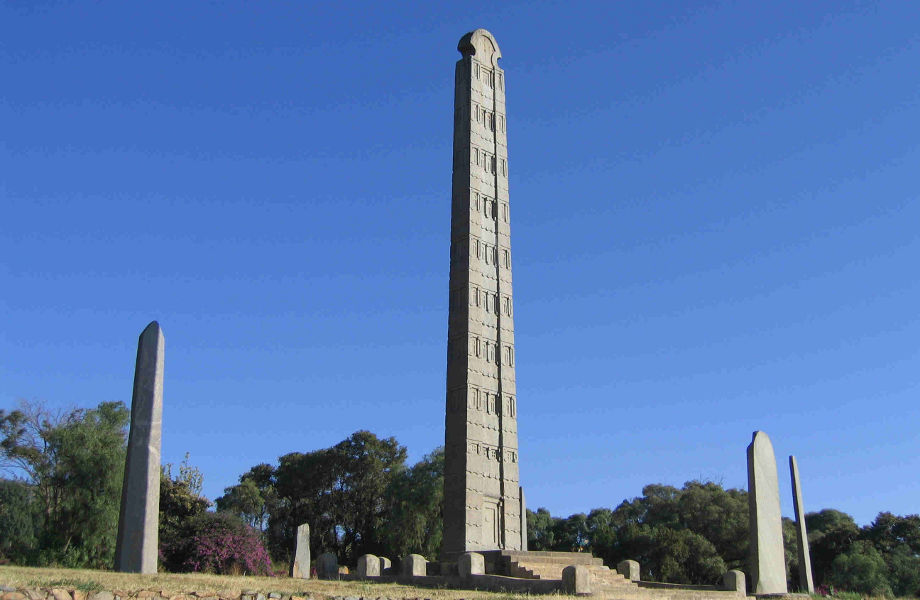Historic Route Most tourists see Ethiopia for the first time by traveling on what is generally known as the Historic Route, and indeed many of them assume that this is Ethiopia in its entirety. Certainly the five-stop itinerary of this well-travelled tour gives fascination and interest aplenty. With the natural scenery of Bahir Dar and Lake Tana and its fascinating and colourful monasteries, the imposing castles of Gondar, the ancient monuments of Axum and the Tigray region, the unimaginable wonders of Lalibela’s rock-hewn churches, the memorable and daunting visions offered by the Simien Mountains, and the numerous and imposing sights of Mekele in the extreme north and Ethiopia’s capital city of Addis Ababa further south, the traveller will not want for interest and variety.
What to see and do

To reach the source of the Blue Nile, which rises from Lake Tana on the outskirts of Bahir Dar, you can either walk or hire a bicycle, or take a local minibus to about 1km past the Blue Nile Springs Hotel, where a large bridge crosses the river. The wide river provides ideal conditions for hippos and crocodiles, both of which are occasionally seen from the bridge.
You can also visit a palace built for Haile Selassie on top of a hill. Although entrance to, and photography of, the palace are forbidden, the hill offers excellent views over the town and Lake Tana.
The market in Bahir Dar is also worth a visit, and a good place to buy furry injera baskets. Also try the pleasant walk to the fish market on the lake shore where you will also see a great many papyrus tankwa boats and often large numbers of pelicans.
Tis Abay Falls

About 30km after it exits Lake Tana, the Blue Nile plunges over a 45m high rock face to form one of Africa’s most spectacular waterfalls, Tis Abay (‘Smoke of the Nile’) or Tis Isat (‘Water that Smokes’). Tis Abay is impressive for the sheer volume of water that pours over it, particularly during the rainy season. However, the recent installation of a hydro-electric plant that diverts around 95% of the water when it is operating means that the waterfall is not always running. Most official guides in Bahir Dar are honest about the situation, so ask them when the best time to go is.
The most straightforward way of visiting the waterfall is to organise a half-day excursion with a reputable tour operator. It is also very easy to visit the waterfall independently. Buses run daily between Bahir Dar and the village of Tis Abay and the trip takes about an hour. Once at the village you’ll need to visit the ticket office and pay an entrance fee. You’re not obliged to hire a guide, but the alternative may be that a whole cluster of kids follow you asking for money. It’s a 30 minute walk from the village to the main viewpoint over the waterfall.
Most people visit Tis Abay as a day trip from Bahir Dar, but there are a couple of basic hotels in the village should you want to spend the night there. A more attractive option may be to camp by the waterfall. You can camp freely anywhere in the area, though you are advised to bring all your food with you from Bahir Dar. You might also want to organise a guard at the police station.
Gondar
Gondar is probably the most immediately impressive of Ethiopia’s major ex-capitals, but it is perhaps less enduringly memorable than either Axum or Lalibela. Gondar is one of Ethiopia’s largest cities, yet it has retained its friendly character and is generally considered to be one of the most welcoming towns on the ‘tourist route’. Much of the modern town centre dates from the Italian occupation of 1936-41, although in the last few years a number of bars and hotels have been built or refurbished.
History
Gondar was founded in 1635 by Emperor Fasiledes. For several centuries Ethiopia had been ruled from a succession of temporary capitals and Fasiledes recognised that a permanent capital might help provide greater internal stability.
By the time of Fasiledes’ death in 1667 Gondar was the largest and most important city in the empire. It retained its position as the capital of Ethiopia for 250 years, though this status was largely nominal from the late 18th century onwards.
What to see and do

The Royal Enclosure lies at the heart of Gondar and gives the city much of its character. Containing five castles, and several smaller buildings, it is a fascinating place to explore. It may be worth hiring a guide as they are very knowledgeable. The most impressive castle, built by Fasiledes around 1640, shows a unique combination of Portuguese, Axumite and even Indian influences.
About 2km out of town lies the large sunken Fasiledes bathing pool. The pool is still used for the Timkat Festival which takes place every January. Tickets cannot be bought at the pool itself but entrance is included in the price for visiting the Royal Enclosure (providing you visit both on the same day).
The church of Debre Birhan Selassie, a half-hour walk out of town, is regarded by some experts to contain the finest art of its period anywhere in Ethiopia. The church is most famous for its roof which is decorated with a painting of 80 cherubic faces. Apparently Emperor Yohannis I intended to move the Ark of the Covenant here from Axum. Photography is permitted but useless without a flash or tripod.
Simien Mountains

The Simien range lies north of Gondar and to the east of the main road to Axum. The western side of the range has been designated the Simien Mountains National Park. The Simien range is one of Africa’s largest mountain ranges: many of its peaks rise above 4,000m and Mount Ras Dashen (4,620m) is the highest point in Ethiopia and the fourth highest peak in Africa.
Most parts of the Simiens are inaccessible to vehicles, but the range is crossed by a number of tracks used by the local people, which make ideal walking routes. Combined with the impressive scenery, this makes the Simiens an excellent area for trekking.
Trekking
Most trekking routes take you through small villages and terraced fields in the lower valleys, before reaching a series of dramatic cliffs and escarpments. Beyond the escarpments you reach the beautiful alpine meadows and the rugged wilderness of the high peak areas.
You have several route options, depending on the time you have and the distance you want to cover (some spend ten days trekking, but most people take a shorter trek). Your route is also determined by the places where you can sleep the night and find water.
A much-needed rest
Most visitors stay near the National Park camps (at Sankaber, Geech and Chenek) as they are spaced around a day’s walk apart and have a good water supply.
You should not underestimate the effects of altitude when planning your route. Make sure you have had time to acclimatise.
If the prospect of setting up your own trip seems a little daunting you can set up an organised trek through a tour operator in Addis Ababa.
History

Roha, as the town was known at the time, was the capital of the Zagwe Dynasty which ruled over Ethiopia from the 10th century to the mid-13th century. Its modern name, Lalibela, derives from the most famous of the Zagwe rulers, the 12th-century King Lalibela.
What to do there
People visit Lalibela for the churches. And, no matter if you have visited other rock-hewn churches in Ethiopia, nothing will prepare you for these. The Lalibela churches are big – several are in excess of 10m high – and, because they are carved below ground level, they are ringed by trenches and courtyards, the sides of which are carved into with stone graves and hermit cells, and connected to each other by a tangled maze of tunnels and passages. In size and scope, the church complex feels like a subterranean village. Yet each individual church is unique in shape and size, precisely carved and minutely decorated. Lalibela is, in a word, awesome.
It is in the church Bet Medhane Alem, in the northwestern cluster of churches, that you will find the 800-year-old Lalibela Cross, which is made of solid gold and reportedly weighs around 7kg. It is said to have been the personal property of King Lalibela, and is perhaps the most treasured artefact of the Ethiopian church, more holy than anything in Jerusalem or Rome.
Axum

Axum lies in the northern province of Tigre, the cradle of Ethiopian culture. Axum is the oldest city in Ethiopia (it was the ancient capital) and is the holiest city of the Ethiopian Orthodox Church. It is smaller than you might expect and rather inauspicious on first impression, but it does boast some stunning antiquities. In addition to Axum’s historical importance, visitors can enjoy a hassle-free atmosphere and can go about their business in virtual peace.
History
The roots of modern Ethiopia lie in the Axumite Empire, though nobody knows for certain when Axum and its empire were founded. However there are few that would query that Axum was one of the most important and technologically advanced civilisations of its time, or that it was a major force in world trade between the 1st and 7th centuries AD. Some idea of Axum’s contemporary importance is given by the 3rd century Persian writer, Manni, who listed it as one of the four great kingdoms in the world, along with Persia, China and Rome. Ethiopians believe that the Ark of the Covenant is held at Axum, and though this may be questioned the town has retained its position as the centre of Ethiopian Christianity.
What to see and do
A guided tour of the town takes several hours, and two days are required if you want to see everything of interest. But don’t forget to bring along your torch.
The exemplary Axum Museum illustrates just how cosmopolitan and technologically advanced the city was. Here you can purchase a pass which will allow you access to all the historical sites in and within walking distance of the town over as many days as you need (except for the church compound).
At the main stelae field it is possible to see the most impressive technological achievement of the Axumites, who erected several solid granite stelae, the largest of which (now collapsed) was taller even than the similar granite obelisks in Egypt.
Next will probably come the St. Mary of Zion Church, inside which there are some good paintings and musical instruments (note women may not enter the church). The Ark of the Covenant is allegedly kept in a sanctified building within the compound of the church, though don’t expect to be able to see it!
Other historical sites include Queen Sheba’s Swimming Pool and the Pantaleon Monastery. The monastery is situated on a euphorbia-clad hill known as Debre Katin, and boasts one of the oldest and most historically important churches in the country. Women may enter the monastery compound and see the various holy crosses and books, but the church itself is men only.

